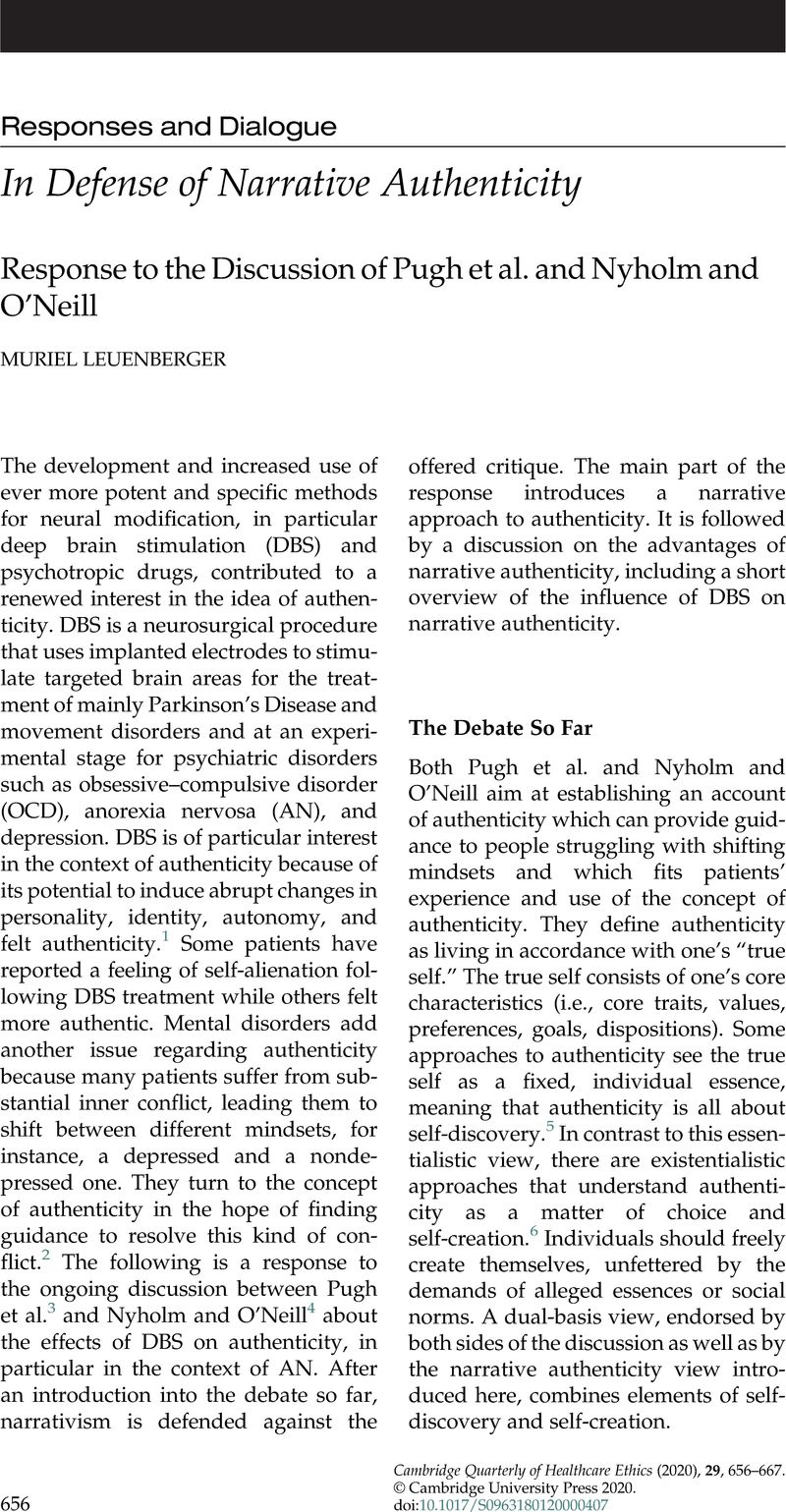Article contents
In Defense of Narrative Authenticity
Response to the Discussion of Pugh et al. and Nyholm and O’Neill
Published online by Cambridge University Press: 07 September 2020
Abstract

- Type
- Responses and Dialogue
- Information
- Cambridge Quarterly of Healthcare Ethics , Volume 29 , Special Issue 4: Clinical Neuroethics , October 2020 , pp. 656 - 667
- Copyright
- © Cambridge University Press 2020
References
Notes
1. Although more studies are needed to clarify to what extent those changes are directly caused by the DBS implant and how often such changes occur, see Gilbert, F, Vinaña, JNM, Ineichen, C. Deflating the “DBS causes personality changes” bubble. Neuroethics 2018 Jun:1–17 CrossRefGoogle Scholar, it is nevertheless ethically relevant to discuss those changes and the involved concepts; see Pugh, J, Pycroft, L, Maslen, H, Aziz, T, Savulescu, J. Evidence-based neuroethics, deep brain stimulation and personality—deflating, but not bursting, the bubble. Neuroethics 2018 Dec:1–12.CrossRefGoogle Scholar
2. Erler, A, Hope, T. Mental disorder and the concept of authenticity. Philosophy, Psychiatry, & Psychology 2014;21(3):219–32.CrossRefGoogle Scholar
3. Pugh, J, Maslen, H, Savulescu, J. Deep brain stimulation, authenticity and value. Cambridge Quarterly of Healthcare Ethics 2017;26(4):640–57.CrossRefGoogle ScholarPubMed
4. Nyholm, S, O’Neill, E. Deep brain stimulation, continuity over time, and the true self. Cambridge Quarterly of Healthcare Ethics 2016;25(4):647–58CrossRefGoogle ScholarPubMed; Nyholm, S, O’Neill, E. Deep brain stimulation, authenticity and value: Further reflections. Cambridge Quarterly of Healthcare Ethics 2017;26(4):658–70.CrossRefGoogle Scholar
5. See, for example, The President’s Council on Bioethics. Beyond Therapy. Biotechnology and the Pursuit of Happiness. New York, NY: Regan Books; 2003 Google Scholar; Elliott, C. Better than Well: American Medicine Meets the American Dream. New York, NY: Norton; 2003 Google Scholar; and Rousseau, J-J. The Confessions and Correspondence, Including the Letters to Malesherbes. Hanover, NH: University Press of New England; 1995.Google Scholar
6. See, for example, Sartre, J-P. Being and Nothingness. London, UK: Routledge; 1991 Google Scholar and DeGrazia, D. Prozac, enhancement, and self-creation. The Hastings Center Report 2000;30(2):34–40.CrossRefGoogle ScholarPubMed
7. See note 3, Pugh et al. 2017, at 645.
8. See note 4, Nyholm, O’Neill 2017, at 664.
9. See note 4, Nyholm, O’Neill 2016, at 651.
10. Schechtman, M. The Constitution of Selves. Ithaca NY; London, UK: Cornell University Press; 1996, at 110–1.Google Scholar
12. Glover, J. I: The Philosophy and Psychology of Personal Identity. London, UK: Penguin Books; 1988.Google Scholar
13. See note 3, Pugh et al. 2017, at 644.
14. MacIntyre, AC. After Virtue. Notre Dame: University of Notre Dame Press; 1984.Google Scholar
15. In contrast to narrative self views of, for example, Charles Taylor or Alasdair MacIntyre. See note 14, MacIntyre 1984 and Taylor, C. Sources of the Self. Cambridge, UK: Harvard University Press; 1989.Google Scholar
16. We may not be able to make a rational, first-personal decision about a transformative experience before undergoing it, but looking back we can make sense of the changes the experience initiated. See Paul, LA. Transformative Experience. Oxford: Oxford University Press; 2014.CrossRefGoogle Scholar
17. See note 10, Schechtman 1996, at 122–5.
18. This does not imply that one cannot be authentically conflicted or ambiguous; more on that in the section “Advantages of narrative authenticity.”
19. Yates, R. Revolutionary Road. London, UK: Vintage Books; 2007.Google Scholar
20. In particular, the existentialists stressed the importance of action for self-definition and authenticity.
21. In psychology, this is typically discussed under the term self-efficacy.
22. Heidegger discussed authenticity in terms of a self-owned life. To be authentic, or eigentlich, a person has to take action in a self-determined and independent manner. By externalizing central parts of the self-narrative and describing them as happening to oneself, this ownership necessary for authenticity is lacking.
23. Parens, E. Authenticity and ambivalence: Toward understanding the enhancement debate. The Hastings Center Report 2005;35(3):34–41.CrossRefGoogle ScholarPubMed
24. I mainly discussed the authenticity of persons, defined as having a certain kind of self-narrative. A single action, thought, or feeling is authentic if it is in accordance with such a self-narrative. Someone has had an authentic life if he mostly acted, thought, and felt authentically.
25. See note 2 Erler, Hope 2014, at 219–32.
26. See note 2 Erler, Hope 2014.
27. For an overview, see Schechtman, M. The narrative self. In: Gallagher, S, ed. The Oxford Handbook of the Self. Oxford: Oxford University Press; 2011, at 394–418.Google Scholar
28. For an overview, see Crossley, ML. Introducing Narrative Psychology: Self, Trauma, and the Construction of Meaning. Buckingham, UK: Open University Press; 2000.Google Scholar
29. See note 6, DeGrazia 2000.
30. Hope, T, Tan, J, Stewart, A, Fitzpatrick, R. Anorexia nervosa and the language of authenticity. Hastings Center Report 2011;41(6):25.Google ScholarPubMed
31. Korsgaard, CM. Self-Constitution. Oxford: Oxford University Press; 2009 CrossRefGoogle Scholar; Frankfurt, HG. Freedom of the will and the concept of a person. The Journal of Philosophy 1971;68(1):5–20 CrossRefGoogle Scholar; and Ekstrom, LW. A coherence theory of autonomy. Philosophy and Phenomenological Research 1993;53(3):599–616 CrossRefGoogle Scholar. I do not advance a view on autonomy at this point. I discuss the rational endorsement approach because it is the basis of Pugh et al.’s notion of authenticity.
33. Alessandro Ferrara discussed this distinction between autonomy and authenticity in his analysis of Rousseau’s work. See Ferrara, A. Modernity and Authenticity: A Study in the Social and Ethical Thought of Jean-Jacques Rousseau. Albany, NY: State University of New York Press; 1993.Google Scholar
- 8
- Cited by




